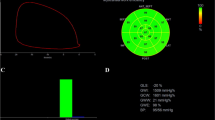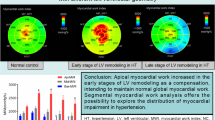Abstract
Myocardial work (MW) is a novel parameter that incorporates non-invasive estimates of left ventricular (LV) systolic pressure into the interpretation of strain, thus overcoming the limitations of load dependency traditionally encountered with LV fractional shortening (LVFS), ejection fraction (LVEF), and global longitudinal strain (GLS). However, data on MW in the pediatric population with hypertension are lacking. Conventional markers of LV function and MW indices were obtained from 88 echocardiographic examinations in 76 children with hypertension (47 males, 15.5 ± 2.96 years). When compared with a previously published cohort of 52 healthy controls, global work index (GWI) and global constructive work (GCW) were both significantly elevated while LVEF and GLS were not impaired but rather mildly increased. On multivariable analysis, GWI was correlated with systolic blood pressure (slope = + 16, p < 0.001) and GLS (slope = −100, p < 0.001), while GCW was correlated with systolic blood pressure (slope = + 18, p < 0.001), GLS (slope = −101, p < 0.001), male sex (slope = −75, p = 0.016), and LV mass (slope = −0.93, p < 0.001). Global wasted work (GWW) was correlated with age at echo visit (slope = −4.5, p = 0.005) and GLS (slope = + 5.5, p < 0.001). The opposite occurred for global work efficiency (GWE; slope = + 0.20, p = 0.011, and slope = −0.48, p < 0.001, respectively). Principal component analysis and k-means clustering revealed 4 subphenotypes which differed in terms of etiology, afterload, and compensation stage of the disease.
Conclusion: Non-invasive MW shows a good correlation with conventional markers of LV function and may help refine the assessment of hypertensive heart disease in children.
What is Known: • Myocardial work (MW) is a novel parameter that incorporates non-invasive estimates of left ventricular (LV) systolic pressure into the interpretation of strain, thereby accounting for both deformation and afterload. • Although the usefulness of MW in the assessment of myocardial function beyond conventional markers has been demonstrated in various clinical populations, data in the pediatric population with hypertension are currently lacking. | |
What is New: • Compared to normal values in healthy children, global work index and global constructive work were increased in those with hypertension, while LV ejection fraction and global longitudinal strain were not impaired. • Machine learning identified 4 subphenotypes which differed in terms of etiology, afterload, and compensation stage of the disease. |



Similar content being viewed by others
Code availability
The code used for this study will be made available from the corresponding author upon reasonable request.
Abbreviations
- AIC:
-
Akaike Information Criterion
- ANOVA:
-
Analysis of variance
- BSA:
-
Body surface area
- DBP:
-
Diastolic blood pressure
- GCW:
-
Global constructive work
- GLS:
-
Global longitudinal strain
- GWE:
-
Global work efficiency
- GWI:
-
Global work index
- GWW:
-
Global wasted work
- IQR:
-
Interquartile range
- LV:
-
Left ventricle/ventricular
- LVEF:
-
Left ventricular ejection fraction
- LVFS:
-
Left ventricular fractional shortening
- LVM:
-
Left ventricular mass
- LVMi:
-
Left ventricular mass index
- MW:
-
Myocardial work
- PCA:
-
Principal component analysis
- SBP:
-
Systolic blood pressure
- SD:
-
Standard deviation
References
Saito M, Khan F, Stoklosa T, Iannaccone A, Negishi K, Marwick TH (2016) Prognostic implications of LV strain risk score in asymptomatic patients with hypertensive heart disease. JACC Cardiovasc Imaging 9:911–921
Potter E, Marwick TH (2018) Assessment of left ventricular function by echocardiography: the case for routinely adding global longitudinal strain to ejection fraction. JACC Cardiovasc Imaging 11:260–274
Adamo L, Perry A, Novak E, Makan M, Lindman BR, Mann DL (2017) Abnormal global longitudinal strain predicts future deterioration of left ventricular function in heart failure patients with a recovered left ventricular ejection fraction. Circ Heart Fail 10
Tadic M, Sala C, Carugo S, Mancia G, Grassi G, Cuspidi C (2021) Myocardial strain in hypertension: a meta-analysis of two-dimensional speckle tracking echocardiographic studies. J Hypertens 39:2103–2112
Burns AT, La Gerche A, D’Hooge J, MacIsaac AI, Prior DL (2010) Left ventricular strain and strain rate: characterization of the effect of load in human subjects. Eur J Echocardiogr 11:283–289
Yingchoncharoen T, Agarwal S, Popović ZB, Marwick TH (2013) Normal ranges of left ventricular strain: a meta-analysis. J Am Soc Echocardiogr 26:185–191
Russell K, Eriksen M, Aaberge L, Wilhelmsen N, Skulstad H, Remme EW, Haugaa KH, Opdahl A, Fjeld JG, Gjesdal O, Edvardsen T, Smiseth OA (2012) A novel clinical method for quantification of regional left ventricular pressure-strain loop area: a non-invasive index of myocardial work. Eur Heart J 33:724–733
Galli E, Leclercq C, Hubert A, Bernard A, Smiseth OA, Mabo P, Samset E, Hernandez A, Donal E (2018) Role of myocardial constructive work in the identification of responders to CRT. Eur Heart J Cardiovasc Imaging 19:1010–1018
Boe E, Russell K, Eek C, Eriksen M, Remme EW, Smiseth OA, Skulstad H (2015) Non-invasive myocardial work index identifies acute coronary occlusion in patients with non-ST-segment elevation-acute coronary syndrome. Eur Heart J Cardiovasc Imaging 16:1247–1255
Lustosa RP, Butcher SC, van der Bijl P, El Mahdiui M, Montero-Cabezas JM, Kostyukevich MV, Rocha De Lorenzo A, Knuuti J, Ajmone Marsan N, Bax JJ, Delgado V (2021) Global left ventricular myocardial work efficiency and long-term prognosis in patients after ST-segment-elevation myocardial infarction. Circ Cardiovasc Imaging 14:e012072
Galli E, Vitel E, Schnell F, Le Rolle V, Hubert A, Lederlin M, Donal E (2019) Myocardial constructive work is impaired in hypertrophic cardiomyopathy and predicts left ventricular fibrosis. Echocardiography 36:74–82
Chan J, Edwards NFA, Khandheria BK, Shiino K, Sabapathy S, Anderson B, Chamberlain R, Scalia GM (2019) A new approach to assess myocardial work by non-invasive left ventricular pressure-strain relations in hypertension and dilated cardiomyopathy. Eur Heart J Cardiovasc Imaging 20:31–39
Tadic M, Cuspidi C, Saeed S, Lazic JS, Vukomanovic V, Grassi G, Sala C, Celic V (2021) The influence of left ventricular geometry on myocardial work in essential hypertension. J Hum Hypertens
Loncaric F, Marciniak M, Nunno L, Mimbrero M, Fernandes JF, Fabijanovic D, Sanchis L, Doltra A, Montserrat S, Cikes M, Lamata P, Bijnens B, Sitges M (2021) Distribution of myocardial work in arterial hypertension: insights from non-invasive left ventricular pressure-strain relations. Int J Cardiovasc Imaging 37:145–154
Jaglan A, Roemer S, Perez Moreno AC, Khandheria BK (2021) Myocardial work in stage 1 and 2 hypertensive patients. Eur Heart J Cardiovasc Imaging 22:744–750
Flynn JT, Falkner BE (2017) New clinical practice guideline for the management of high blood pressure in children and adolescents. Hypertension 70:683–686
Mitchell C, Rahko PS, Blauwet LA, Canaday B, Finstuen JA, Foster MC, Horton K, Ogunyankin KO, Palma RA, Velazquez EJ (2019) Guidelines for performing a comprehensive transthoracic echocardiographic examination in adults: recommendations from the American Society of Echocardiography. J Am Soc Echocardiogr 32:1–64
de Simone G, Daniels SR, Devereux RB, Meyer RA, Roman MJ, de Divitiis O, Alderman MH (1992) Left ventricular mass and body size in normotensive children and adults: assessment of allometric relations and impact of overweight. J Am Coll Cardiol 20:1251–1260
Tretter JT, Pradhan S, Truong VT, Mullikin A, Mazur W, Hill GD, Redington AN, Taylor MD (2021) Non-invasive left ventricular myocardial work indices in healthy adolescents at rest. Int J Cardiovasc Imaging 37:2429–2438
Bogaert J, Rademakers FE (2001) Regional nonuniformity of normal adult human left ventricle. Am J Physiol Heart Circ Physiol 280:H610-620
Goh VJ, Le TT, Bryant J, Wong JI, Su B, Lee CH, Pua CJ, Sim CPY, Ang B, Aw TC, Cook SA, Chin CWL (2017) Novel index of maladaptive myocardial remodeling in hypertension. Circ Cardiovasc Imaging 10
Gaudron PD, Liu D, Scholz F, Hu K, Florescu C, Herrmann S, Bijnens B, Ertl G, Stork S, Weidemann F (2016) The septal bulge–an early echocardiographic sign in hypertensive heart disease. J Am Soc Hypertens 10:70–80
Sahiti F, Morbach C, Cejka V, Albert J, Eichner FA, Gelbrich G, Heuschmann PU, Stork S (2021) Left ventricular remodeling and myocardial work: results from the population-based STAAB Cohort Study. Front Cardiovasc Med 8:669335
Huang J, Yang C, Yan ZN, Fan L, Ni CF (2021) Global myocardial work: a new way to detect subclinical myocardial dysfunction with normal left ventricle ejection fraction in essential hypertension patients: compared with myocardial layer-specific strain analysis. Echocardiography 38:850–860
Acknowledgements
J. Van den Eynde was supported by the Belgian American Educational Foundation.
Author information
Authors and Affiliations
Contributions
Mr. Zhan, Ms. Long and Mr. Van den Eynde conceptualized and designed the study, collected data, carried out the initial analyses, drafted the initial manuscript, and reviewed and revised the manuscript. Drs. Ozdemir, Hays, Danford, Barnes, and Kutty conceptualized and designed the study, coordinated and supervised data collection, and critically reviewed the manuscript for important intellectual content. All authors approved the final manuscript as submitted and agree to be accountable for all aspects of the work.
Corresponding author
Ethics declarations
Ethics approval
This study conforms to the ethical guidelines of the 1964 Declaration of Helsinki as reflected by a priory approval by our institution’s Human Research and Ethic Committee.
Consent to participate
Individual informed consent was waived by the Committee given the retrospective nature of this study.
Consent for publication
Individual informed consent was waived by the Committee given the retrospective nature of this study.
Conflict of interests
S. Kutty is consultant for GE Healthcare. All other authors declare that they have no competing interests. This research did not receive any specific grant from funding agencies in the public, commercial, or not-for-profit sectors.
Additional information
Communicated by Peter de Winter
Publisher's Note
Springer Nature remains neutral with regard to jurisdictional claims in published maps and institutional affiliations.
Rights and permissions
About this article
Cite this article
Zhan, J., Van den Eynde, J., Ozdemir, E. et al. Left ventricular myocardial work indices in pediatric hypertension: correlations with conventional echocardiographic assessment and subphenotyping. Eur J Pediatr 181, 2643–2654 (2022). https://doi.org/10.1007/s00431-022-04447-2
Received:
Revised:
Accepted:
Published:
Issue Date:
DOI: https://doi.org/10.1007/s00431-022-04447-2




